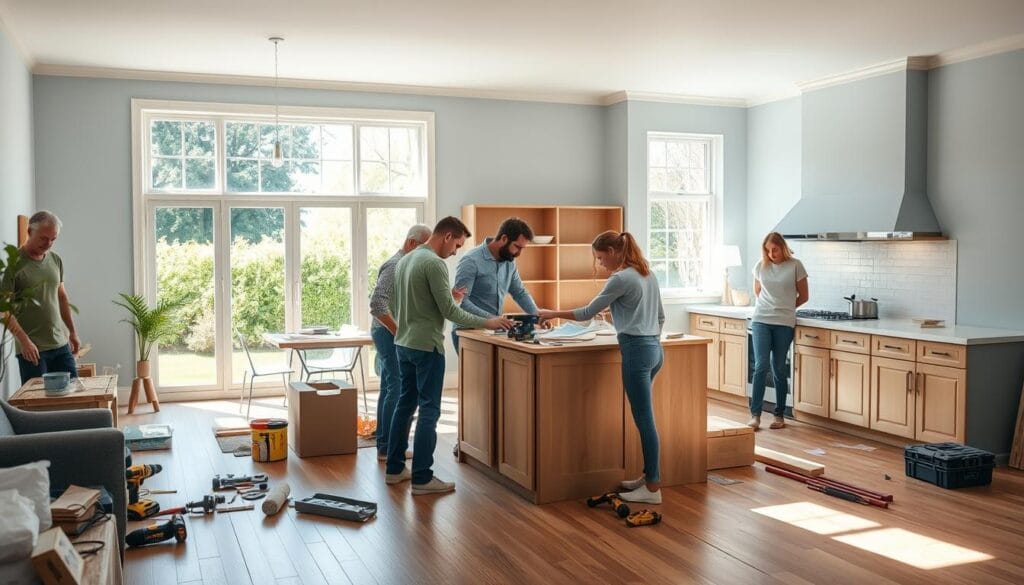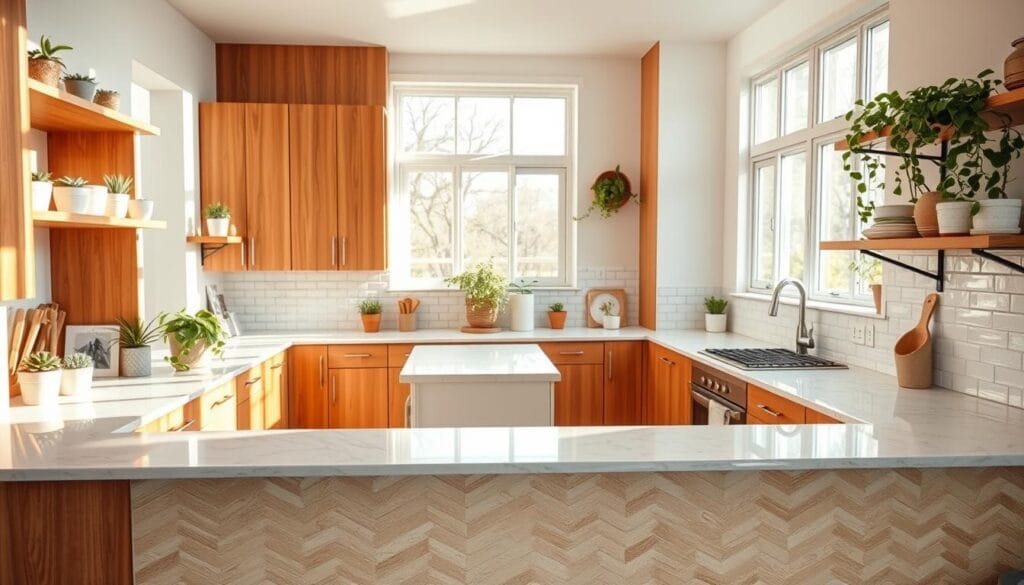Walking into an old house is exciting. You see its potential. We bought our home in 2012. It was charming but needed love. Built in 1903, it had a lot of history. The plumbing and support beams were original, telling stories from over 120 years ago. We were set on turning it from outdated to stunning with our DIY efforts.
Our DIY journey was filled with big tasks, like putting up shiplap boards and taking down walls. We worked hard to get the floors just right and picked the perfect insulation. Replicating the traditional molding was a proud moment. We did more than just fix up a house. We brought a piece of history back to life.
DIY updates are more than just physical changes. They let us add our personal touch everywhere. We installed a new bay window to make the kitchen brighter. We also put in a water filter which saves us money every year. And our LED bulbs cut down our energy use by 75%, which is great for the planet.
If you’re thinking about a DIY project or just dreaming, know it’s possible. Changing your home with your own work is rewarding. Jump into the world of home makeovers. Let’s see how you can make your space shine, one DIY project at a time!
Introduction to DIY Home Renovations
Taking on DIY home renovations allows you to update your space in your own style. You’ll save money, increase your home’s value, and enjoy the process. It’s key to know what you need to do. This lets you focus on the most important projects without spending too much.
Understanding the Benefits of DIY Renovations
DIY projects are great for saving money. For example, a renovation in 2016 needed £80,000 but made a big difference. Compared to the high costs of fully renovated homes, DIY gives you financial flexibility.
Doing it yourself also brings personal joy. You get to choose how everything looks, showing off your personal style. This makes your space not only work better but look great, too.
Assessing Your Renovation Needs
It’s crucial to know what your home needs before starting. Check carefully for any repairs or updates needed. Doing things like drainage or asbestos surveys can reveal hidden problems. This helps you budget better and avoid surprises.
Understanding local property values is also key. It guides how much you should spend, especially if you plan to sell later. Having a good project management plan can make the work go smoother. Tools like Google Sheets or Smartsheets help keep things organized.
By carefully evaluating what needs to be done, you can make sure your renovations are worthwhile. This approach ensures you get the most out of your time and money.
Budget-Friendly Renovations: Where to Start
Starting home improvements on a budget is not scary. With a firm plan and a specific budget, you can start many affordable renovations. They transform your place without emptying your wallet. Let’s look at smart, budget-wise renovation ideas.
Planning and Budgeting for Your Renovation
Success in affordable renovations comes from careful planning and realistic budgeting. Before starting, assess your needs and set a precise budget. This approach prevents extra costs. It keeps your renovation tasks organized and wallet-friendly.
- Identify the areas of your home that need improvement.
- Research cost-effective materials and DIY methods.
- Create a detailed budget, including a cushion for surprises.
- Prioritize projects by urgency and impact.
“A well-planned budget is the cornerstone of any successful renovation. It guides your decisions and ensures that you stay on track financially.”
Affordable Home Improvement Ideas
There are many budget-friendly renovation ideas. Here are some that make a big difference without costing too much:
- Refurbish and Reuse: Update old furniture with new paint or handles.
- Smart Use of Peel-and-Stick: For a quick, cheap update, use peel-and-stick floors or backsplash tiles.
- Lighting Upgrades: Adding dimmer switches or modern light fixtures can instantly change a room’s feel.
- DIY Projects: Make custom headboards or floating shelves for unique home additions.
- Window Treatments: Refresh your space by hanging new curtains or shades on existing rods.
- Fresh Paint: A new coat of paint can completely transform walls, cabinets, or stairs.
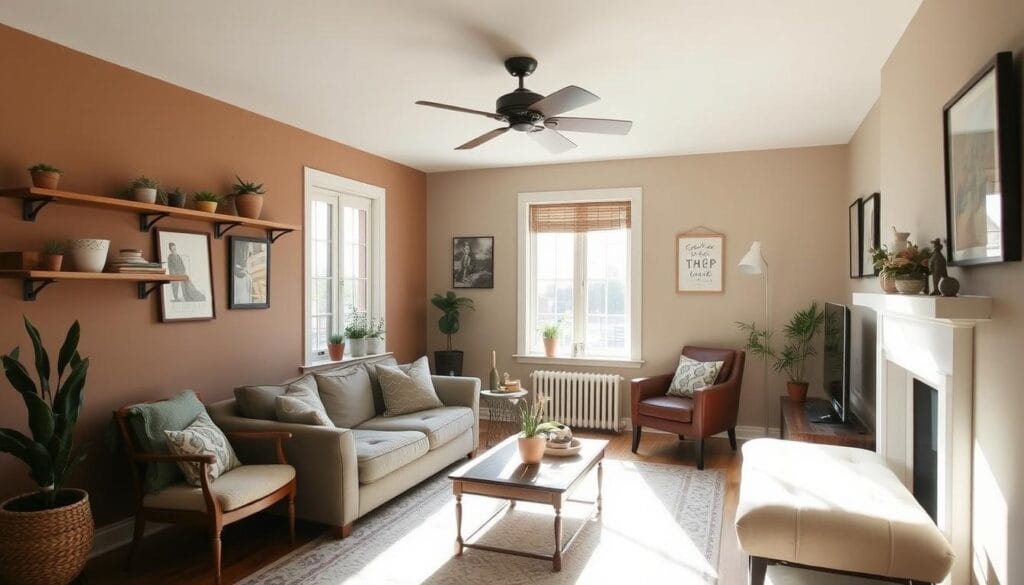
| Improvement | Average Cost |
|---|---|
| Repainting the front door | $100 – $220 |
| Installing peel-and-stick flooring | $1 – $4 per sq. ft. |
| Replacing bathroom hardware | $25 – $500 |
| Upgrading kitchen backsplash | $200 – $300 |
| Adding artwork | $10 – $800 |
By using these smart strategies, you can significantly improve your home on a budget. The aim is to better your living area while being clever with money. Happy renovating! 🏡
Transforming Your Home with Paint
Have you noticed how fresh paint can make a room look and feel new? It’s a budget-friendly way to update your space. Let’s look at home painting basics, like picking paint colors and learning cool DIY paint tricks.
Choosing the Right Colors
Finding the right paint color can be tricky. Colors show your style and change a room’s mood. Cool colors bring calmness, while warm colors add warmth and energy. Think about what the room is for and the vibe you want. And, don’t forget about the natural light in the room.
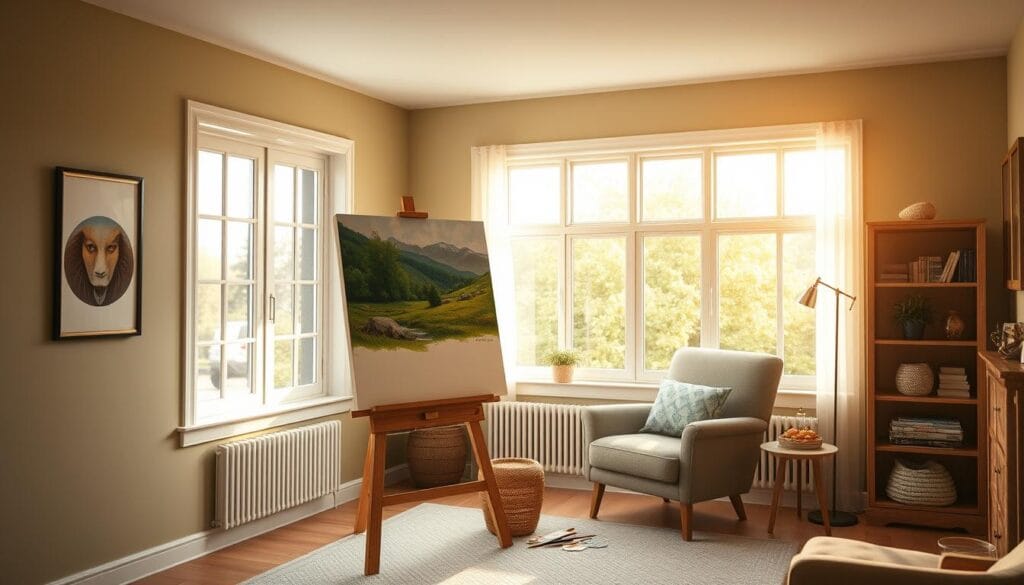
We’ve learned to try color samples on walls before deciding. This lets you see how colors look at different times of the day. It helps avoid surprises and makes sure everything matches your decor.
Paint Techniques That Make a Difference
Plain walls are boring. Let’s add some texture and personality. Here are some DIY paint tricks to change up your space:
- Sponging: Use a sponge for a cool, textured look. It adds depth to your paint color.
- Stenciling: Great for adding intricate patterns without wallpaper.
- Color blocking: Mix contrasting colors to make a modern look with little effort.
Starting these paint tricks might seem hard, but it’s doable. It feels great to turn a plain wall into something special. Plus, doing it yourself can save you around $1,000 compared to paying pros!
Painting does more than just look good. A new paint job can make your home’s air fresher. This is especially good if you use paints with low or no VOCs. It’s a great choice for families who care about clean air at home.
So, try out a big painting project or just update a few rooms. Get creative and be patient to see wonderful results. Doing it yourself not only saves money but also makes you proud of transforming your home.
DIY Home Renovations: Fixing the Basics First
Starting with the basics is key in any home makeover. Before you jump into big changes, focus on fixing home basics. This makes sure your home is safe and lasts longer. We’ll outline the main things to concentrate on for a strong start.
First up, look for any leaks or signs of water damage. If you ignore moisture, it can lead to big trouble, hurting your other renovation efforts. By taking care of leaks early, you protect your home from more harm and expensive fixes later. Keep an eye on your roof, pipes, and basement for water buildup.
Then, think about how well your home is insulated. Good insulation helps control the temperature and cuts down on energy use. This step is very important when fixing up your home yourself, because it can save you a lot of money on energy bills. Make sure your attic, walls, and floors have enough insulation, and improve it if needed.

Checking the structure of your home is also vital. Look over the foundation, walls, and beams for any damage. Keeping these parts in good shape stops future problems and keeps your home safe. Regular upkeep and quick fixes help save both time and money.
Lastly, before you make any decorative updates, check that all mechanical systems are current. This includes your heating, cooling, electrical, and plumbing systems. They are essential for your home to work right and meet safety standards. Updating old systems improves your home’s performance and value.
Dealing with these home basics first creates a solid base for more makeovers. A home built on a strong foundation is more fun to beautify. By handling these key tasks first, you’re set to turn your space into a stunning and efficient home. 🛠️
| Issue | Action Required | Benefit |
|---|---|---|
| Leaks & Water Damage | Repair promptly | Prevents costly repairs and further damage |
| Insulation | Upgrade where needed | Improves energy efficiency and comfort |
| Structural Integrity | Inspect and repair | Ensures safety and longevity |
| Mechanical Systems | Update and maintain | Enhances functionality and compliance |
Interior Design DIY: Enhancing Your Space
Unleashing your creativity with interior design DIY is very rewarding! About 75% of homeowners think their homes look old. Now is the perfect time to start DIY decor projects.
Begin by cleaning deeply and getting rid of clutter. This is advised by 90% of interior designers. It’s the key first step for any redesign, making any room feel new and open. A tidy home also helps make your daily life easier. Upgrading window treatments can also cut down energy use by 25%, saving on bills.
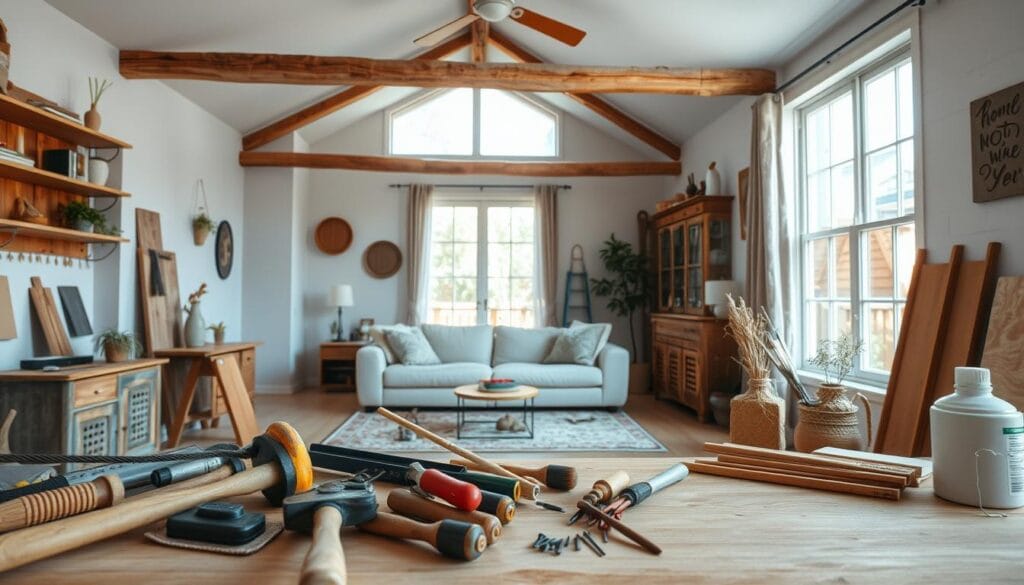
For more impact, try repainting. New paint can make your home seem up to 10% more valuable. Colors that are neutral are liked by 80% of potential buyers. This can make selling your home easier in the future.
Lighting upgrades can make your home 30% brighter, changing its feel and look. Refreshing your bathroom fixtures can boost satisfaction by 50%. Updating your kitchen gives the best return on investment, say 70% of real estate agents.
DIY decor lets you add your special touch. Custom furniture or unique storage not only looks great but also shows off your style. These storage solutions keep your place tidy and functional. You might want to try building your own shelves to use space well.
Don’t ignore your outdoor areas. Making these better can add 20% to your home’s value, especially in sunny areas. These spaces can turn your home into a personal paradise.
In short, DIY decor projects make you feel proud and turn your home into a special place. Every new project, like a brushstroke or a light fixture, makes your home feel special. So, get ready for your next interior design DIY project!
From Outdated to Outstanding: Transforming Your Home with DIY Renovations
Turning your home from dull to impressive by yourself is truly rewarding. We’ve looked at many inspiring home makeover stories to motivate your own projects. These stories show the journey from simple beginnings to stunning endings, offering great lessons.
Before and After: Success Stories
A standout story is updating a gloomy, dated dining room into a bright, welcoming area. It was transformed with new paint, lights, and furniture. This shows that even small changes can have a big impact.
Another success is a living room makeover completed in spring 2018. It changed from dull to striking with vibrant colors and comfortable furniture. It proves that with good planning and effort, you can achieve your dream space.
Bathroom remodels can be tricky, dealing with pipes and small spaces. We’ve seen five amazing bathroom makeovers. They turned tight, old bathrooms into relaxing retreats, showing the joys of a challenging renovation.
| Project | Duration | Key Changes |
|---|---|---|
| Living Room | Six Weeks | Bold Accents, Cozy Furnishings |
| Dining Room | Four Weeks | Fresh Paint, New Lighting |
| Bathroom | Eight Weeks | Updated Fixtures, New Tiles |
| Bedroom | Two Weeks | Trim Work, Closet System |
| Kitchen | Twelve Weeks | Brightened Space, Modern Appliances |
It’s not just big rooms that benefit from makeovers. Updating hallways and closets also made a huge difference. These smaller projects add value and make every part of the home special.
Outdoor areas were transformed too. Enhancements like new walkways and gardens greatly improved the home’s look and value. Updating a garage door or adding attic insulation are also smart ways to invest in your home.
Over 35 projects spanning more than 10 years show the impact of DIY renovations. From large kitchen revamps to small trim updates, these stories inspire us. They prove that anyone can make their home go from outdated to outstanding.
Renovating on a Budget: Cost-Saving Tips
Renovating with a limited budget doesn’t mean sacrificing style or quality. By following smart cost-saving renovation tips, you can transform your home without spending too much. It’s important to know when to do it yourself and when to hire professionals. Also, using materials in new ways can save money and make your space unique.
DIY vs. Hiring a Professional
Choosing between DIY and hiring a professional is a major step in renovating. The DIY vs professional choice affects your budget and the outcome. For easy tasks like painting or small repairs, doing it yourself can save 30-50% on labor costs. It also gives you control and a sense of pride in your work.
But, for complicated jobs like plumbing or electrical work, you need to hire an expert. This ensures the work is safe and right, preventing any costly mistakes. Plus, hiring pros during their off-season can save you more due to lower demand.

Repurposing and Upcycling Ideas
Using repurposing and upcycling techniques is great for budget-friendly renovations. Turning old items into something new reduces costs and adds a personal touch. For example, a fresh coat of paint and new knobs can completely change an old cabinet. This approach can also greatly increase the piece’s value.
Looking for materials at places like Habitat for Humanity’s ReStores or auctions can lead to big savings. Making your own artwork instead of buying it can save a lot, adding a unique feel to your space.
By adopting these cost-saving renovation tips and making careful DIY vs professional decisions, you can renovate your home in an affordable yet stylish way. Remember, a successful budget renovation relies on smart planning and using resources creatively.
Create a Cozy and Inviting Living Room
Making your living room a cozy hideaway doesn’t need to cost a lot. You can use easy, cozy living room ideas and careful planning. Even DIY fans can make a space that’s both warm and well put together. Let’s look at some DIY projects and smart tips for arranging furniture. These ideas will spark your creativity and make your home look better.
DIY Projects for the Living Room
Starting DIY projects for your living room is fun and can save money. Simple changes like new fabric on old chairs or custom window treatments can change the room’s look. For as little as $200, painting the walls can make a big difference in the vibe, making it a key tip for a cozy living room.
Try making your own wall art or stylish shelves for books and decorations. These additions bring your personality to the room without spending much. Choose reclaimed wood or affordable laminates for furniture or shelves. This keeps costs down while adding a rustic touch.
Furniture Arrangement Tips
Arranging your living room furniture well is key to making it welcoming. Pick a focal point like a fireplace or big window, and put your furniture around it. This setup encourages talking and closeness. Don’t push all your furniture against the walls. Bringing pieces closer makes the space feel more united and cozy.
Flexible furniture options let you change the setup to keep the room interesting and practical. The right lighting, including ambient, task, and accent lights, is important for both looks and usefulness. Choose smart and efficient lighting to follow sustainable living trends.
| Project Type | Estimated Cost | Impact |
|---|---|---|
| Painting Walls | $200 | High |
| Custom Shelving | $50-$200 | Medium |
| Reupholstering Furniture | $100-$500 | High |
| Window Treatments | $20-$150 | Medium |
Using the space wisely and arranging furniture smartly can make your living room more inviting. Take on DIY projects to make the space your own and feel good about your work. A smart furniture setup shows off your space’s beauty and makes your home welcoming.
Boosting Curb Appeal with Exterior Renovations
Improving the outside of your home can make a big difference. Homebuyers often pay up to 10% more for homes that look great from the outside. We will look at simple repairs and DIY gardening tips to increase your home’s value and charm!
Simple Fixes for Your Home’s Exterior
- Fresh Coat of Paint: Adding a new coat of paint can return about 107% of your investment when you sell. Repainting your front door and trim makes your home welcoming.
- Update Exterior Lighting: Replacing old lights with modern, efficient ones improves your home’s look and safety.
- Clean and Repair Siding: Keeping siding clean and fixing any damage can result in a 75% to 90% return on investment, boosting your home’s appeal.
- Replace Windows: New energy-efficient windows not only lower your energy bills by 15% to 30% but also make your home more attractive to buyers.
DIY Landscaping Tips
According to experts, good landscaping can increase your property’s value by 5% to 15%. Here are some DIY landscaping tips to enhance your home’s appearance:
- Lawn Maintenance: Keeping your lawn neat can improve curb appeal by 70%. This means regular mowing, edging, and fertilizing.
- Planting Trees and Shrubs: Well-placed trees and shrubs can cool your home and make it look better.
- Design a Walkway: A nicely designed path can make your home seem more valuable by up to 10%. You can use brick, stone, or concrete for a beautiful and lasting walkway.
- Install a Garden: Adding flower beds or a vegetable garden adds color and life to your yards, making them more inviting and useful.
Spending time on outdoor home improvements or enjoying DIY gardening can greatly increase your home’s attractiveness and value. Homeowners see big value increases after making these changes, showing it’s a smart move!
Essential Tools for DIY Renovators
Starting your DIY renovation journey? It’s key to have the right tools for DIY renovations. A well-equipped DIY toolkit keeps you ready for both big and small tasks. Let’s look into some essential renovation tools every renovator needs.
First off, no DIY toolkit is complete without a power drill. The RIDGID Drill/Driver, at $119, brings 1,300 lbs. of torque, perfect for tough jobs. On the other hand, the Dewalt Drill/Driver offers portability with its 20-Volt cordless setup for $139.
Now, let’s chat about saws. For cutting wood or getting joints just right, a dependable saw is key. The Ryobi 12″ Sliding Miter Saw, for $219, includes a laser for precise cuts. Meanwhile, the Dewalt 12″ Compound Miter Saw is a top pick at $399. For more demanding tasks, the RIDGID 12″ Sliding Miter Saw has a 70-degree bevel, costing $499. The Milwaukee 10″ Sliding Miter Saw, a battery-operated option, is $599.
A hammer drill is essential for drilling into hard surfaces like concrete or brick. A reciprocating saw, on the other hand, easily cuts through wood, metal, and plastic.
Let’s not forget about hand tools. A solid claw hammer is a must-have for various tasks, like driving or pulling out nails. A tape measure is crucial for accurate measurements.
Your safety is super important too. Wearing safety glasses and using a voltage tester prevent accidents, keeping you safe while you work.
Finally, enhance your DIY toolkit with tools such as pipe wrenches for plumbing jobs, step ladders for reaching high spots, and paint sprayers for smooth paint application. With these essential tools, every project becomes easier, more efficient, and rewarding!
Conclusion
We’ve explored the exciting world of DIY home renovation, covering both simple updates and big changes. You can save money or go all out on your projects. Hands-on work can refresh outdated areas, reflecting your unique taste and needs.
Small updates like new light fixtures (cost: $100 – $900) or a smart thermostat ($200 – $500) can have a big impact. Bigger projects, such as redoing your kitchen ($10,000 – $200,000) or adding a new bathroom ($45,000 – $165,000), also add value. They improve how you use and enjoy your home.
Even when a project ends, your creativity doesn’t have to stop. Keep enjoying DIY work and find new ways to personalize your space. Gaining confidence from these projects helps you make any space better. Here’s to your future DIY successes! 🌟

